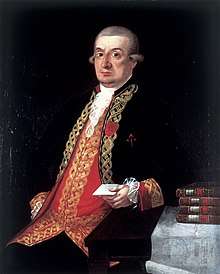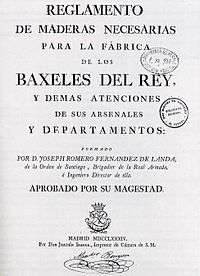José Romero y Fernández de Landa
José Romero y Fernández de Landa (27 May 1735 in Huelva – 5 August 1807 in Madrid) was a Spanish naval and army officer and the Spanish Navy's first official naval engineer and ship designer. He designed several two and three deck ships of the line in the late 18th and early 19th centuries which fought at the Battle of Cape St Vincent and the Battle of Trafalgar. He is also notable as the writer of Reglamento de maderas necesarias para la fábrica de los baxeles del Rey (Rules for the wood necessary for building the King's ships).
José Romero y Fernández de Landa | |
|---|---|
 | |
| Born | 27 May 1735 Huelva |
| Died | 5 August 1807 (aged 72) Madrid |
| Other work | Naval engineer |
Life
On 27 May 1752 he joined the Regimiento de Dragones de Edimburgo at Villa de Arcos, commanding a company, but he moved to the navy in 1754. He rose 'alférez de fragata' (ensign) and commanded the 5th Company of the 2nd Battalion of Marines at Ferrol.

On 1 November 1765 he started working at the shipyard at Guarnizo, under the designer Francisco Gautier. In October 1770, on the creation of the Cuerpo de Ingenieros de Marina, he was one of its few officials from the Cuerpo de Oficiales de Guerra to join the new body. He was 'capitán de fragata', Commandant of the Engineers and Engineer General, rising to Engineer General of the Fleet on 28 January 1786.
Warships designed by Landa
112-gun ships

74-gun ships
64 gun ships
The three 64-gun ships designed by Landa were an extension of his 74-gun designs, changing its main dimensions on a scale of α=49,5/52
| Fecha de Botadura | Nombre del Navío | Astillero |
|---|---|---|
| 3 November 1787 | San Fulgencio | Cartagena[1] |
| 27 November 1787 | San Leandro | Ferrol[2] |
| 27 June 1788 | San Pedro Alcántara | La Habana[3] |
Frigates

| Launch date | Name | Shipyard |
|---|---|---|
| 12 March 1784 | Santa Casilda | Cartagena[1] |
| 4 March 1786 | Santa Florentina | Cartagena[1] |
| 3 May 1788 | Nuestra Señora de la Soledad | Cartagena[1] |
| 2 October 1789 | Mahonesa | Mahón |
| 31 July 1789 | Perla | Cartagena[1] |
| 1791 | Preciosa | Cádiz |
References
- digitum.um.es (ed.). "Cartagena: El Arsenal Ilustrado del Mediterraneo español" (PDF). Retrieved 28 July 2009.
- armada15001900.net (ed.). "Listado de barcos de los Reales Astilleros de Esteiro" (PDF). Retrieved 28 July 2009.
- bpvillena.ohc.cu (ed.). "La Habana antigua y moderna. Capítulo X. Arsenal". Retrieved 28 July 2009.
Bibliography
- (in Spanish) José Romero Fernández de Landa, Un Ingeniero de Marina del Siglo XVIII, de José María de Juan-García Aguado, Universida de da Coruña, 1998. ISBN 84-89694-66-4